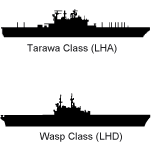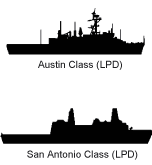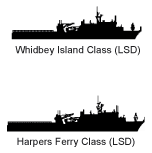|
The Future of the Navy's Amphibious and Maritime Prepositioning Forces November 2004 Section 2 of 6 |
The Department of the Navy's vision for military transformation, known as Sea Power 21, rests on three key concepts: Sea Strike, Sea Shield, and Sea Basing. The first two concepts focus on improving the Navy's and Marine Corps's offensive and defensive capabilities, respectively. But the third, Sea Basing, is considered by many in the Department of Defense to be the most transformational of the three ideas. It envisions putting a substantial Marine Corps ground force on shore and sustaining it from ships at sea rather than from a land base. Thus, the Navy and Marine Corps could conduct amphibious assaults (including "forcible-entry" operations, like those conducted on Japanese-held Pacific islands during World War II) without needing to seize enemy territory to build a base or to get permission from a nearby country to use an existing base. Supporters argue that sea basing would therefore allow U.S. forces to operate overseas more independently, flexibly, and quickly. Although the entire fleet would play a role in the "sea base," the most important vessels for that concept are the Navy's amphibious warfare ships--which carry marines and their equipment--and new prepositioning vessels intended to provide much of the logistics support for Marine Corps units operating on shore.(1) Over the next 30 years, the Navy plans to replace most of its amphibious ships as well as buy the new class of logistics ships, which it calls the Maritime Prepositioning Force (Future), or MPF(F). Carrying out that plan would cost more than twice as much per year, on average, as the Navy has spent on amphibious ships since 1980, the Congressional Budget Office (CBO) estimates.(2) Such a spending increase may not prove feasible; consequently, this study looks at four ways to modernize the Navy's amphibious and maritime pre-positioning forces at lower cost. Some of those alternatives would support sea basing and some would emphasize other capabilities, such as providing overseas (forward) presence.
Organization of the Amphibious and Maritime Prepositioning ForcesToday, amphibious ships make up 12 percent of the Navy's fleet, or 35 out of 293 ships (see Summary Figure 1). Those vessels--referred to collectively as L-class ships--include 12 large amphibious assault ships (known as LHAs or LHDs), 11 amphibious transport docks (LPDs), and 12 dock landing ships (LSDs). All three types of ships carry marines, vehicles, and the landing craft that are used to ferry troops and equipment to shore; some also carry helicopters and fixed-wing aircraft. (For a description of the different types of amphibious warfare ships and the roles they play, see Summary Box 1.) Together, L-class ships provide the lift (transport capacity) to carry 1.9 Marine expeditionary brigades (MEBs), or about 27,000 troops and their equipment--less than the Navy's stated goal of 2.5 MEBs' worth of lift.
Composition of the Current and 375-Ship Battle Force Fleets 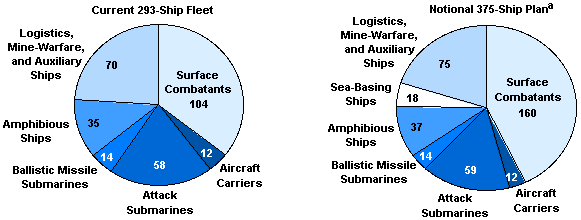 Source: Congressional Budget Office based on data from the Navy. Notes: Current maritime prepositioning ships are not included in the 293-ship fleet because the Navy does not consider them battle force ships. In the 375-ship plan, new, more-capable maritime prepositioning ships are included and are called sea-basing ships. Attack submarines include four Ohio class ballistic missile submarines that are being converted to carry conventional guided missiles. a. The Navy's plan for a 375-ship fleet, submitted in May 2003, included 37 amphibious ships and 18 sea-basing ships. CBO's analysis, consistent with more-recent information, assumes that the 375-ship fleet would include 36 amphibious ships and 16 sea-basing ships.
In the past, amphibious warfare ships were organized into 12 amphibious ready groups (usually of three ships each), which generally operated independently of other ships in the fleet. Each group carried a Marine expeditionary unit of about 2,200 troops, equivalent to an infantry battalion. Under a plan announced in 2003, however, the Navy is reorganizing its fleet to assign three surface combat ships and one submarine to operate with each amphibious ready group. The resulting task forces are called expeditionary strike groups, which is the term used in this study. Separate from its main fleet, the Navy has 16 maritime prepositioning ships--conventional cargo vessels operated by the Military Sealift Command (the organization responsible for providing ocean transportation services to the Department of Defense). Unlike amphibious warfare ships, maritime prepositioning ships do not carry troops, only equipment. They are organized into three squadrons of five or six ships apiece and are based at ports in the Mediterranean Sea, the Indian Ocean, and the western Pacific. Each squadron holds all of the military hardware and supplies needed to equip a Marine expeditionary brigade and sustain it for 30 days. Thus, those ships together provide a total lift capacity of 3.0 MEBs. Maritime prepositioning vessels are not counted in what the Navy call its ship battle forces and do not have the capability to engage in forcible-entry operations. Instead, they require a secure port for unloading equipment and a secure airfield where troops can fly in from the United States to pick up the equipment and assemble for operations. The Navy and Marine Corps assume, on the basis of various planning factors, that if the Marines needed to forcibly seize a port and airfield first, the first Marine unit getting its equipment from a maritime prepositioning squadron would be ready to operate in eight weeks. If a port and airfield were already available--as was the case in both wars against Iraq--the first such unit could be ready within two weeks. In March 2003, the Navy sent a report to the Congress that proposed building a fleet of 375 ships, including 37 amphibious ships and 18 new maritime prepositioning ships capable of conducting sea-basing operations (see Summary Figure 1). Under the 375-ship plan, some or all of those new prepositioning ships would be counted as part of the battle fleet by virtue of their combat capability. Together, amphibious and maritime prepositioning ships would make up 15 percent of that fleet. (More-recent information suggests that the 375-ship fleet would include 36 amphibious ships and 16 sea-basing ships.)
The Navy's Plan to Modernize the Amphibious and Maritime Prepositioning Forces Under the Sea-Basing VisionThe Navy intends to replace most of its current amphibious and maritime prepositioning ships over the next 30 years (see Summary Table 1). Its plan for those forces includes:
Schedule for Replacing Existing Amphibious and Maritime Prepositioning Ships with New Classes
Source: Congressional Budget Office based on data from the Navy. Note: MPS = maritime prepositioning squadron; MPF(F) = Maritime Prepositioning Force (Future). a. Tarawa, the first LHA to retire, will be replaced by Makin Island, the last of the LHDs. b. Projected. c. Through 2004, six of the 12 LPD-17s had already been purchased. d. Most of these ships will be transferred to the Ready Reserve Fleet to replace cargo ships that will be scrapped. e. CBO assumes that 16 ships will have sea-basing capabilities and five will be replacement cargo ships. Under that plan, the Navy would have 57 amphibious warfare and maritime prepositioning ships by 2035 (see Summary Figure 2), compared with 51 in 2004. Those ships would be organized into 12 expeditionary strike groups and three maritime prepositioning squadrons.
Inventory of Amphibious and Maritime Prepositioning Ships Under the Navy's Plan 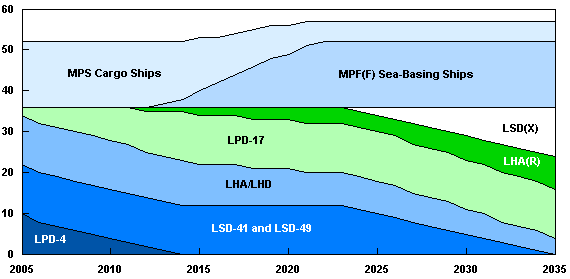 Source: Congressional Budget Office based on data from the Navy. Note: MPS = maritime prepositioning squadron; MPF(F) = Maritime Prepositioning Force (Future). By 2035, each expeditionary strike group would comprise one large amphibious assault ship of either the LHD or LHA(R) class, an LPD-17, and an LSD(X). Of the maritime prepositioning squadrons, two would consist of ships with sea-basing capabilities, and one would consist of replacement cargo vessels like those used today. All together, those forces could provide a total lift capacity of 5.5 MEBs (2.5 MEBs on the amphibious warfare ships, 2.0 MEBs on the sea-basing ships, and 1.0 MEB on the conventional cargo ships). In the Navy's and Marine Corps's vision for sea basing, amphibious ships would continue to carry the "assault echelons"--the first wave of troops--in any expeditionary operation. The MPF(F) ships would carry most of the material needed to sustain that force in the first 20 days of operations. They would also hold all of the equipment for "follow-on assault echelons"--successive waves of troops that would be transported to the theater on aircraft or high-speed surface craft. With sea basing, no land base would be necessary for the follow-on forces to assemble themselves and deploy--all of that would occur on the ships composing the sea base. Nor would there be a large supply depot on land to offer a prime, stationary target for attacks by enemy ballistic missiles, cruise missiles, or aircraft. The MPF(F)s are the linchpin of the sea base; without them, the Navy and Marine Corps would not be able to implement that new approach to amphibious warfare or forcible-entry operations. Carrying out the Navy's plan for amphibious and maritime prepositioning forces would require spending an average of $2.4 billion a year (in 2005 dollars) on ship construction between 2005 and 2035, CBO estimates--more than twice the Navy's average annual spending to build amphibious and maritime prepositioning ships between 1980 and 2004. If costs to operate and support those forces were included, the Navy would need to spend an average of $5.4 billion per year over the 2005-2035 period. That planned increase in spending comes at a time when Navy officials are envisioning other modernization programs--for surface combatants, submarines, aircraft carriers, and support ships--that would also require greater spending on ship construction. Building the proposed
375-ship fleet would cost an average of about $19 billion annually through 2035, CBO estimates, compared with average funding of less than $12 billion a year since 1980. Spending on amphibious and maritime prepositioning ships would represent about 12 percent of total shipbuilding costs, up from an average of 9 percent between 1980 and 2004 (see Summary Figure 3).
Projected Funding to Construct a 375-Ship Fleet Compared with Actual Ship Funding (Billions of 2005 dollars)
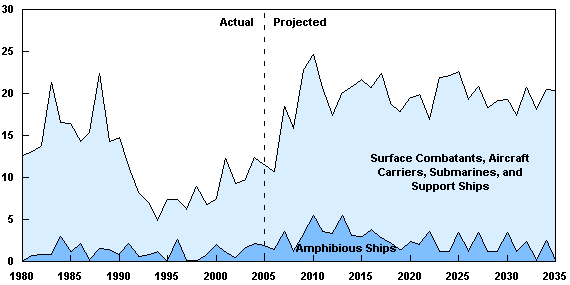 Source: Congressional Budget Office. Note: The data in this figure are roughly analogous to the cost-risk case for ships presented in Congressional Budget Office, The Long-Term Implications of Current Defense Plans: Summary Update for Fiscal Year 2005 (September 2004). Many questions remain about the future size of the Navy's amphibious forces and the viability of the sea-basing concept. The Navy may find that modernizing its amphibious warfare force and purchasing new MPF(F) vessels are difficult to afford simultaneously. Some Navy officials have suggested reducing the number of L-class ships in order to buy the MPF(F)s. That and other recent proposals for reductions in the force structure suggest that senior Navy leaders do not think the 375-ship goal is viable. If a battle fleet of that size proves too expensive, the Navy's current plans for amphibious and maritime prepositioning ships may change. In addition, the sea-basing idea is still in its early stages of development. Important conceptual issues and technological problems will have to be solved before that idea can become a reality. Furthermore, a growing number of military leaders and analysts contend that sea basing needs to be joint (in other words, that all of the military services need to be involved in its development and funding). What role the Army and the Air Force would play in that effort, however, is not yet clear.
Lower-Cost Alternatives to the Navy's PlanCBO constructed four alternative plans for the future of amphibious and maritime prepositioning forces that would lessen the funding challenge the Navy is facing with its shipbuilding budget as a whole and with those forces in particular. All of the alternatives would result in a smaller amphibious force than exists today, and some would result in a smaller prepositioning force as well. Each option would take a different approach to modernizing amphibious and maritime prepositioning ships:
CBO found no alternative that could do more with less. Saving money on the amphibious warfare and maritime prepositioning forces, relative to the Navy's plan, requires buying fewer ships and thus having less capability. Unless the Navy can provide a level of resources equivalent to that required to implement its current plan, choices will have to be made about how to structure those forces in the future. Questions include, What should the balance be between expeditionary strike groups and maritime prepositioning squadrons? Does the Navy need 12 expeditionary strike groups and three maritime prepositioning squadrons? What role should sea basing play in the design of the future maritime prepositioning force? Would the MPF(F) ships be survivable enough to operate in a hostile coastal environment? The options that CBO examined offer different ways to answer those questions. Option 1A: Buy Fewer, More-Capable Ships Within the Historical Spending LevelSince 1980, the Navy has devoted an average of about $1.1 billion annually to construction of amphibious ships (and the occasional maritime prepositioning ship that it has purchased rather than leased). On the assumption that the average funding level for those vessels will not increase over the next 30 years, this option would buy the new types of ships that the Navy envisions but in much smaller numbers than under the Navy's plan. This approach would gradually reduce the number of expeditionary strike groups by half (from 12 to six) and the number of maritime prepositioning squadrons by one-third (from three to two). To compensate somewhat for those cuts, one of the maritime prepositioning squadrons would be given sea-basing capabilities. (The other squadron would consist of replacement cargo ships with the same capability as today's maritime prepositioning ships.) Under this option, the Navy would buy four of the new LHA(R) amphibious assault ships through 2035, instead of 10 as under the Navy's plan; five rather than 12 new LSD(X)s that would be larger than today's dock landing ships; and one squadron of eight sea-basing-capable MPF(F) ships instead of 16. This option would also purchase seven LPD-17 dock landing ships rather than 12 and a squadron of five conventional cargo ships. By 2035, the inventory of amphibious and maritime prepositioning ships would total 31 vessels, compared with 57 under the Navy's plan (see Summary Figure 4). Of that total, 26 would be L-class ships and sea-basing-capable maritime prepositioning ships, versus 52 under the Navy's plan.
Inventory of Amphibious and Maritime Prepositioning Ships Under Alternative Force Structures 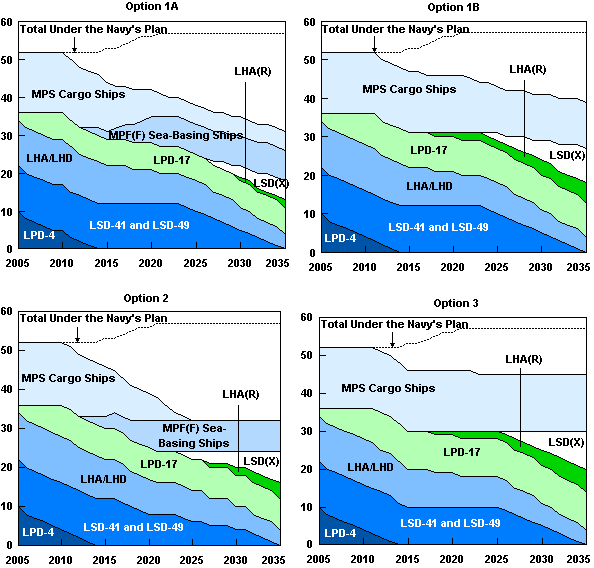 Source: Congressional Budget Office based in part on data from the Navy. Note: MPS = maritime prepositioning squadron; MPF(F) = Maritime Prepositioning Force (Future). Option 1B: Buy More, Less-Capable Ships Within the Historical Spending LevelIf the Navy was forced to fund amphibious and maritime prepositioning ships at the historical level of about $1.1 billion a year but was reluctant to cut the L-class force to the extent envisioned in Option 1A, it could retain a larger number of ships by not investing in new designs. This option illustrates that approach: it would keep the future amphibious warfare and maritime prepositioning forces at a greater size than under Option 1A but would not pursue the enhanced sea-basing capability sought by the Navy and Marine Corps. In other words, for the same amount of money, this approach would emphasize quantity over quality, and Option 1A would do the opposite. In this alternative, the number of expeditionary strike groups would gradually be cut by one-quarter, from 12 to nine (leaving 50 percent more than in Option 1A). The number of maritime prepositioning ships would be reduced with just over half a squadron rather than by a whole squadron. Amphibious assault ships would be replaced with ships similar in size and capabilities to existing classes, and maritime prepositioning ships would be replaced with modern cargo ships that lacked sea-basing capabilities. Thus, the Navy would purchase six LHA(R)s over the 2005-2035 period, but those vessels would replicate today's amphibious assault ships rather than offer enhanced aviation capabilities, as the Navy plans. The LPD-17 program would end at nine ships instead of 12. Likewise, the Navy would buy nine LSD(X)s rather than 12, and those ships would be similar in size and capabilities to existing dock landing ships. By 2035, the total inventory of amphibious and maritime prepositioning vessels would number 39 ships, and the amphibious warfare force would number 27 ships. Option 2: Create a More Survivable Sea-Basing ForceTo save money, senior Navy leaders have proposed cutting the number of expeditionary strike groups from 12 to eight--and thus reducing the number of amphibious warfare ships--and using the savings to buy two squadrons of sea-basing-capable MPF(F)s. This option follows that approach, with one significant difference: it would increase the survivability of the MPF(F) ships. As currently planned, those vessels would be much less survivable than amphibious warfare ships. They would have little or no ability to defend themselves from attack and would have difficulty continuing to operate if they were struck--even though they would be the largest (except for aircraft carriers), the most detectable, and thus the most targetable Navy ships in a theater of operations. To address that issue, this option would build MPF(F)s that were closer, though not equal, in survivability to L-class amphibious ships. Because a more survivable MPF(F) would be more expensive, this option would buy only eight, or one squadron's worth. In all, this approach would spend an average of $1.5 billion a year on ship construction between 2005 and 2035, compared with $2.4 billion under the Navy's plan. Under this alternative, the LPD-17 program would stop at eight ships instead of 12. The LHA(R) program would be delayed from 2007 until 2022, and six of those ships would be purchased through 2035. The LSD(X) program would begin at the same time as in the Navy's plan (2020), but only eight ships would be bought rather than 12. This option would also purchase eight sea-basing MPF(F) ships with enhanced survivability, starting in 2009. The last of those MPF(F)s would be fully operational by 2021. Under this alternative, the amphibious warfare force would decline fairly rapidly through 2024, at which time it would level off at 24 ships (eight LPDs, eight LSDs, and eight LHA/LHDs). Together, the amphibious and maritime prepositioning forces would total 32 ships. Option 3: Deemphasize Sea Basing in Favor of Forward PresenceJust as Option 2 represents a slightly more expensive way than Option 1A to procure sea-basing capability, this alternative is a slightly more expensive way than Option 1B to keep larger amphibious and maritime prepositioning forces. Both this approach and Option 1B would forgo sea-basing capability, but this alternative would allow for greater overseas presence than any of the other options that CBO examined. Under this approach, the number of expeditionary strike groups would be cut by one-sixth (from 12 to 10), and the number of maritime prepositioning squadrons would remain at three, although they would consist of new cargo vessels much like today's rather than sea-basing-capable ships. Once implemented, this option would provide peacetime forward presence and maritime prepositioning capabilities that were similar to but slightly less than those of the current force. The Navy and Marine Corps have not conducted an opposed amphibious assault since the Korean War, but in the intervening years, the Navy's amphibious ships have responded frequently to crises around the world. Between 1991 and 2000, for example, amphibious and (on occasion) maritime prepositioning ships took part in at least 55 operations, ranging from disaster-relief efforts to military operations in Iraq, Bosnia, Haiti, and the former Yugoslavia. Cutting the crisis-response capability provided by those ships in order to procure the new sea-basing capabilities of the MPF(F) might not make sense, especially given the challenges involved in making the sea-basing concept work. The Navy would need to develop a host of new technologies for MPF(F) ships as well as acquire new fleets of aircraft and small ships to keep the sea base and the troops it is supporting well supplied, at a potential cost of many billions of dollars. As an alternative to investing in sea-basing capabilities, this option would keep the amphibious and maritime prepositioning forces as large as possible--consistent with saving money--to respond to crises. This approach would end the LPD-17 program at 10 ships instead of 12. It would delay the start of the LHA(R) program from 2007 until 2013 and buy eight ships rather than 10 through 2035. The LSD(X) program would be delayed by two years (from 2020 until 2022), and only 10 ships would be purchased instead of 12. The MPF(F) program would consist of three full squadrons' worth of ships, but they would not have sea-basing capabilities. With those changes, building amphibious and maritime prepositioning ships would cost the Navy an average of $1.5 billion a year between 2005 and 2035. The amphibious warfare force would remain at around 35 ships through 2012 and then quickly level off at 30 ships--10 LPDs, 10 LSDs, and 10 LHA/LHDs, compared with 12 each under the Navy's plan. By 2035, the total inventory of amphibious and maritime prepositioning ships would number 45.
Measures of Capability Under the OptionsTo evaluate the different alternatives in this study and compare them with the Navy's plan, CBO looked not only at total numbers of ships but also at various measures of peacetime and wartime capability. Those measures include the traditional components of amphibious lift on L-class ships (such as the total space available for carrying troops, landing craft, helicopters, vehicles, and cargo); the total amount of lift by all L-class and maritime prepositioning ships; the number of Joint Strike Fighters carried by amphibious assault ships; the number of expeditionary strike groups that are forward deployed (a measure of peacetime forward presence); and the time needed to deploy Marine infantry battalions in a wartime environment. Of the approaches analyzed in this study, the Navy's plan would provide the most capability by all of those measures--but at the greatest cost (see Summary Table 2). The less expensive alternatives that CBO examined offer less capability than that plan and, in many cases, less capability than today's amphibious and maritime prepositioning forces. However, Options 1A and 2 would provide some of the new sea-basing capability that the Navy and Marine Corps desire, and Option 3 would provide slightly more lift capacity than today's force does. |
|||||||||||||||||||||||||||||||||||||||||||||||||||||||||||||||||||||||||||||||||||||||||||||||||||||||||||||||||||||||||||||||||||||||||||||||||||||||||||||||||||||||||||||||||||||||||||||||||||||||||||||||||||||||||||||||||||||||||
The Amphibious and Maritime Prepositioning Forces in 2035 Under Alternative Force Structures
| Force Structure | Average Annual Procurement Cost (Billions of dollars) |
Lift Capacity (Number of MEBs) |
Number of Ships |
Number of Forward-Deployed ESGs |
Number of Marine Infantry Battalions Ashore After |
|||||||||||||||
| All Ships |
Amphibious Ships Onlya |
All Ships |
Amphibious Ships Only |
Using Current Crewing |
Using Crew Rotation |
Four Weeks |
Six Weeks |
Ten Weeks |
||||||||||||
| Navy's Plan | 2.4 | 5.5 | 2.3 | 57 | 36 | 2.7 | 3.6 | 8 | 12 | 15 | ||||||||||
| Option 1A | 1.1 | 3.3 | 1.3 | 31 | 18 | 1.8 | 2.4 | 4 | 6 | 9 | ||||||||||
| Option 1B | 1.1 | 4.3 | 1.8 | 39 | 27 | 2.2 | 3.0 | 2 | 5 | 12 | ||||||||||
| Option 2 | 1.5 | 2.7 | 1.7 | 32 | 24 | 2.1 | 2.8 | 5 | 7 | 7 | ||||||||||
| Option 3 | 1.5 | 5.0 | 2.0 | 45 | 30 | 2.4 | 3.2 | 2 | 5 | 14 | ||||||||||
| Memorandum: | ||||||||||||||||||||
| Current Force | n.a. | 4.9 | 1.9 | 51 | 35 | 2.7 | 3.6b | 2 | 6 | 15 | ||||||||||
Source: Congressional Budget Office. Note: MEB = Marine expeditionary brigade; ESG = expeditionary strike group; n.a. = not applicable. a. Space for troops and vehicles is in relatively short supply on amphibious ships. The Navy has excess capacity in other categories of amphibious lift, such as space for cargo, landing craft, and helicopters. b. The Navy does not employ crew rotation on expeditionary strike groups, although it is planning to experiment with it. This number is shown only for comparability. |
||||||||||||||||||||
|
CBO's analysis suggests that defense officials and lawmakers may have to balance competing priorities. If the operational flexibility of sea basing is considered crucial, the Navy could procure it without an increase from the historical funding level by sharply curtailing the number of amphibious warfare ships (Option 1A). With a 36 percent increase in average funding--less than one-third of the rise needed to carry out current plans--the Navy could achieve some of that capability and also make the ships that possess it less vulnerable to attack (Option 2). Alternatively, if the size of the force and the amount of forward presence it can provide take precedence over sea-basing capability, the Navy could have an amphibious warfare force of about 27 ships by 2035 (compared with 35 today) without a rise in funding (Option 1B). With the same funding increase as in Option 2, it could retain a force of at least 30 L-class ships over the next three decades.
|
|
NEWSLETTER
|
| Join the GlobalSecurity.org mailing list |
|
|
|


